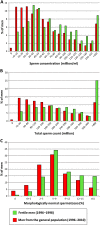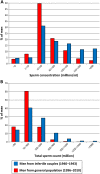Human semen quality in the new millennium: a prospective cross-sectional population-based study of 4867 men
- PMID: 22761286
- PMCID: PMC3391374
- DOI: 10.1136/bmjopen-2012-000990
Human semen quality in the new millennium: a prospective cross-sectional population-based study of 4867 men
Abstract
Objectives: Considerable interest and controversy over a possible decline in semen quality during the 20th century raised concern that semen quality could have reached a critically low level where it might affect human reproduction. The authors therefore initiated a study to assess reproductive health in men from the general population and to monitor changes in semen quality over time.
Design: Cross-sectional study of men from the general Danish population. Inclusion criteria were place of residence in the Copenhagen area, and both the man and his mother being born and raised in Denmark. Men with severe or chronic diseases were not included.
Setting: Danish one-centre study.
Participants: 4867 men, median age 19 years, included from 1996 to 2010.
Outcome measures: Semen volume, sperm concentration, total sperm count, sperm motility and sperm morphology.
Results: Only 23% of participants had optimal sperm concentration and sperm morphology. Comparing with historic data of men attending a Copenhagen infertility clinic in the 1940s and men who recently became fathers, these two groups had significantly better semen quality than our study group from the general population. Over the 15 years, median sperm concentration increased from 43 to 48 million/ml (p=0.02) and total sperm count from 132 to 151 million (p=0.001). The median percentage of motile spermatozoa and abnormal spermatozoa were 68% and 93%, and did not change during the study period.
Conclusions: This large prospective study of semen quality among young men of the general population showed an increasing trend in sperm concentration and total sperm count. However, only one in four men had optimal semen quality. In addition, one in four will most likely face a prolonged waiting time to pregnancy if they in the future want to father a child and another 15% are at risk of the need of fertility treatment. Thus, reduced semen quality seems so frequent that it may impair the fertility rates and further increase the demand for assisted reproduction.
Conflict of interest statement
Figures



Comment in
-
Words of wisdom. Re: Human semen quality in the new millennium: a prospective cross-sectional population-based study of 4867 men.Eur Urol. 2012 Dec;62(6):1197-8. doi: 10.1016/j.eururo.2012.09.018. Eur Urol. 2012. PMID: 23141127 No abstract available.
Similar articles
-
Semen quality of young adult ICSI offspring: the first results.Hum Reprod. 2016 Dec;31(12):2811-2820. doi: 10.1093/humrep/dew245. Epub 2016 Oct 5. Hum Reprod. 2016. PMID: 27707840
-
Body mass index in relation to semen quality and reproductive hormones in New Zealand men: a cross-sectional study in fertility clinics.Hum Reprod. 2013 Dec;28(12):3178-87. doi: 10.1093/humrep/det379. Epub 2013 Oct 15. Hum Reprod. 2013. PMID: 24129611
-
An update on semen quality among young Finnish men and comparison with Danish data.Andrology. 2019 Jan;7(1):15-23. doi: 10.1111/andr.12550. Epub 2018 Sep 24. Andrology. 2019. PMID: 30251363 Free PMC article.
-
Male fertility potential in terms of semen quality: a review of the past, a study of the present.Fertil Steril. 1979 Feb;31(2):103-16. doi: 10.1016/s0015-0282(16)43808-2. Fertil Steril. 1979. PMID: 367823 Review.
-
Semen quality of Asian men.Reprod Med Biol. 2007 Nov 7;6(4):185-193. doi: 10.1111/j.1447-0578.2007.00184.x. eCollection 2007 Dec. Reprod Med Biol. 2007. PMID: 29699277 Free PMC article. Review.
Cited by
-
Fetal Programming of Semen Quality (FEPOS) Cohort - A DNBC Male-Offspring Cohort.Clin Epidemiol. 2020 Jul 17;12:757-770. doi: 10.2147/CLEP.S242631. eCollection 2020. Clin Epidemiol. 2020. PMID: 32765110 Free PMC article.
-
Semen quality in hypogonadal acromegalic patients.Pituitary. 2020 Apr;23(2):160-166. doi: 10.1007/s11102-019-01018-x. Pituitary. 2020. PMID: 31834539
-
How do young men want to receive information about fertility? Young men's attitudes towards a fertility campaign targeting men in Copenhagen, Denmark.Hum Reprod Open. 2021 Jul 27;2021(3):hoab027. doi: 10.1093/hropen/hoab027. eCollection 2021. Hum Reprod Open. 2021. PMID: 34322604 Free PMC article.
-
Iranian temporal changes in semen quality during the past 22 years: A report from an infertility center.Int J Reprod Biomed. 2020 Dec 21;18(12):1059-1064. doi: 10.18502/ijrm.v18i12.8027. eCollection 2020 Dec. Int J Reprod Biomed. 2020. PMID: 33426416 Free PMC article.
-
Hope for male fecundity: clinically insignificant changes in semen parameters over 10 years at a single clinic while assessing an infertility population.J Assist Reprod Genet. 2021 Nov;38(11):2995-3002. doi: 10.1007/s10815-021-02298-8. Epub 2021 Aug 13. J Assist Reprod Genet. 2021. PMID: 34386934 Free PMC article.
References
-
- Wilcox AJ. On sperm counts and data responsibility. Epidemiology 2011;22:615–16 - PubMed
-
- Bonde JP, Ramlau-Hansen CH, Olsen J. Trends in sperm counts, the saga continues. Epidemiology 2011;22:617–19 - PubMed
-
- Skakkebæk NE, Andersson AM, Juul A, et al. Sperm counts, data responsibility, and good scientific practice. Epidemiology 2011;22:620–1 - PubMed
-
- Vogel G. Danish sperm counts spark data dispute. Science 2011;332:1369–70 - PubMed
LinkOut - more resources
Full Text Sources
